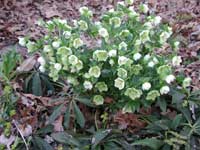Resource Library
Plant of the Week: Rose, Lenten
The University of Arkansas System Division of Agriculture does not promote, support or recommend plants featured in "Plant of the Week." Please consult your local Extension office for plants suitable for your region.
Plant of the Week
Lenten Rose
Latin: Helleborus orientalis

Though spring is still weeks away, a few perennials push the season and are already in full bloom. Lenten rose (Helleborus orientalis) is one of these early bloomers and probably the plant with the most to offer the average gardener interested in late winter bloom.
Lenten rose is one of several species of Hellebores offered as straight species or as hybrid crosses with one of the other 15 species in the group. The earliest to bloom of these, the Christmas rose (H. niger), flowers in December and January but is more difficult to grow than the Lenten rose or its hybrids. Because many of the plants offered as Lenten rose are hybrids with the Christmas rose, the bloom time can range from late January through early April.
This long lived evergreen perennial is a member of the buttercup family and is native to northern Greece and southern Turkey. It grows to 18 inches tall with coarse textured, deep green leaves that arise from an underground rhizome. The leaves are palmately arranged with seven to nine segments.
The flowering stems arise from the ground in late winter along with a new crop of leaves. The flowering stem is erect and terminates in a cluster of branches, each bearing three to five nodding flowers. Flower colors range from white to pink, often with the petal-like sepals marked with darker spots. Because the showy portion of the flower are sepals (modified leaves), they persist for six to eight weeks. But during this long period the bloom color changes. The white flowered forms become more greenish; the pink ones age to deep rose and tan.
The individual blooms are to 2 ½ inches across and have numerous prominent stamens in the center of the flower. Once pollination has been achieved, three angular capsules form in the center of the blossom, but the flower remains attractive as the seeds develop.
All parts of the Lenten rose are poisonous, but there is nothing about the plant likely to tempt children to graze on it. Because of its toxic foliage, it’s one of the best deer-proof plants offered in the nursery trade.
The plant has been cultivated for centuries. Gerard, an Englishman remembered for his 1633 herbal which describes the pharmacopeia of his day, says that the plants were common in London gardens during his time. He also indicates two species were found in the wild in England, probably having been introduced by Roman soldiers during the forth century AD.
Gerard describes a number of medicinal uses for hellebore extracts. Most concoctions were given as purgatives and to worm children, but it was also used to cure melancholy and, if things really got out of hand, to treat insanity. Though Gerard doesn’t mention it, other writers of the time warn that overdoses, especially when worming children, often kill the worms and the patient.
Hellebores are ideal plants for the shade garden because they form evergreen masses and form large, long lasting colonies that persist for years. They tolerate dry shade quite well. If the plant is in a good site, expect it to reseed and increase the size of the colony.
When the new leaves emerge in late winter, the old foliage becomes lax, sprawls across the ground and begins to die. To keep the plant tidy, trim off the old leaves in late winter just as the new crop of shoots begin to emerge.
By: Gerald Klingaman, retired
Extension Horticulturist - Ornamentals
Extension News - March 17, 2006
The University of Arkansas System Division of Agriculture does not maintain lists of retail outlets where these plants can be purchased. Please check your local nursery or other retail outlets to ask about the availability of these plants for your growing area.